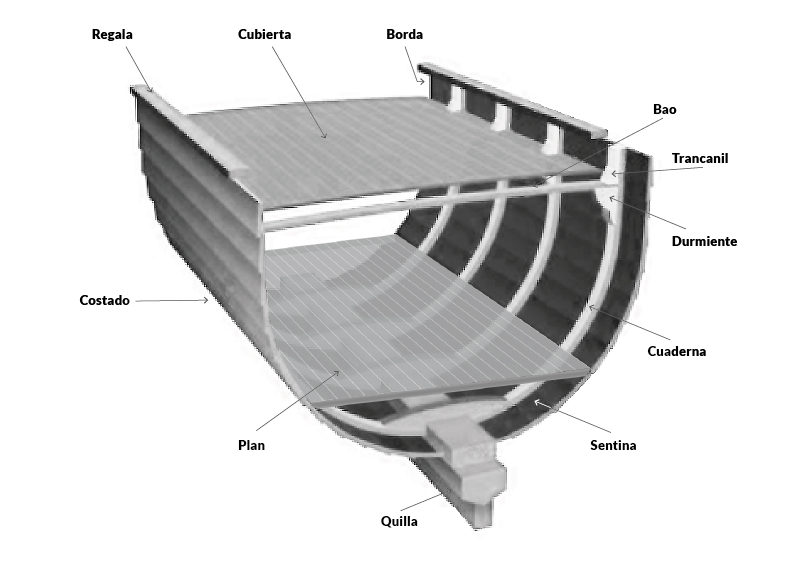Although different types of boat have different parts (a yacht is not the same as a sailboat, to give just two examples), there are some that are common to all of them. Below we explain them so that you can name and recognize them easily.

Bow
Front of the boat, narrower than the rest, to facilitate the navigation of the boat by cutting the waves as it moves forward.
Stern
This is known as the rear of the boat, wider than the bow and where we can find the propellers or the rudder. Also known as a transom.
Port
Located at the stern and facing the bow, left side ship's.
Starboard
On the contrary, situated again at the back of the boat and with his gaze turned towards the previous one, right side of the boat.
Are you interested in: What documentation are you required to carry on your boat?
Line of crujia
imaginary line that split the ship in two longitudinally, leaving one side port and the other starboard.
Sides or across
Each of the parts resulting from dividing the ship along the center line: The port side corresponds to the left side, while the starboard side would be on the right side.
Bulwarks
They correspond with the part of the side that becomes increasingly narrow until converging on the bow. There are also two, the port one and the starboard one.

Fins
Same as the bulwarks, but at the rear of the boat: each of the two parts of the side that converge at the stern. We have a port fin and a starboard fin.
Deck
He boat floor on top, through which the crew and passengers pass, is also the closure of the interior structure of the boat.
Bordeaux and candlesticks
Piece of protection located between deck and gunwale which prevents accidental falls into the sea. On small boats and sailboats it is replaced by protection bars with a cable called stanchions.
Give away
Top of the gunwale which runs along the boat from stern to bow and is covered by a decorative piece called gunwale cover.
Bathtub
This is known as the deck area where the controls are located, the log, the wheel rudder and seats for the crew, as it is the safest area of the boat.
waterline
imaginary line that separates the submerged part of the boat from that which remains out of the water and that may vary depending on its load. Additionally, the line painted on the side of the boat can be called the waterline.
Live work (careen) vs. dead work
The living work, or hull, is the part of the boat that remains submerged inside the water, usually treated to prevent the proliferation of algae or mollusks. On the contrary, the Deadwork is the part of the ship that is above the waterline. and, consequently, out of the water.
Helmet
Exterior area of the boat, which gives it shape and contains inside the rest of its parts, part of which is under the water and part above.
Keel
We can compare it with the ship's spine, the central piece that provides stability to the entire structure. Built of wood or steel, it is the lowest part of the hull and runs from bow to stern.
Stem
Extension of the vertical or oblique keel, which is placed at the front of the boat to form the bow of the ship, joined to the keel by a piece called the stem foot. It can be built in the same material as the keel or a more resistant one.
Codaste
Extension of the keel, built in the same material as this one, which is placed upwards in the rear part of the boat to form the stern.

Notebooks
They are born from the keel and would correspond to the boat ribs: These are the U-shaped pieces that give shape to the hull of the boat.
Baos
It is about the reinforcement pieces that are placed transversely on the frames, joining the stern with the bow and on which the deck of the boat rests.
Bilge
Fundamental part of the boat, located in the lowest area of it, just above the hull. It is in charge of collect spilled water and oil anywhere on the boat and evacuate them to the outside using the bilge pumps installed for this purpose.
Plan
Boat bottom floor, immediately above the keel and bilge.
Bulkheads
Partitions that form the interior divisions of the vessel and which can be longitudinal and transverse.
Length
Boat size, measured in feet lengthwise from bow to stern. One foot corresponds approximately to 30 centimeters.
waterline length
It depends directly on the floating surface of the boat, since it refers to the waterplane length measured between stern and bow.
Sleeve
Boat width, especially in the widest part of it, which normally coincides with the master frame and is known as the maximum beam.
Strut
Boat height, measured vertically from the underside of the boat at the point where it coincides with the keel to the line of the main deck.
Draft
Height of the part of the ship that is submerged in water. It can be measured taking the bottom of the keel and the waterline as references.
Freeboard
Measure the distance between the ship's waterline and the highest watertight deck and indicates its buoyancy reserve, which means that if water penetrates above this value, the boat will sink.




